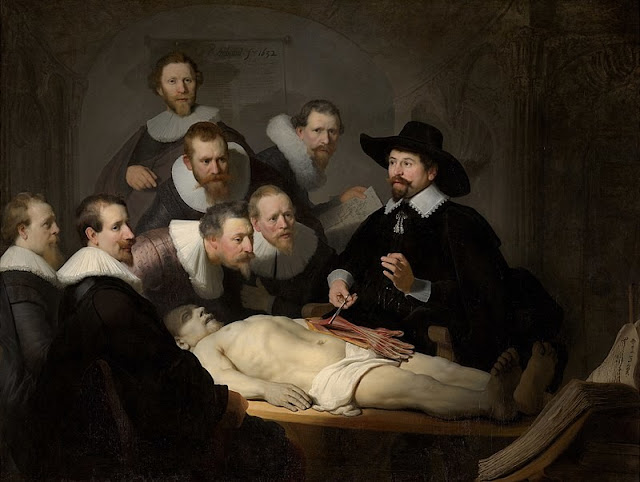 |
| The Anatomy Lesson of Doctor Tulp (1632), Rembrandt. |
On pg 241 of Finnegans Wake there's a reference to this painting by Rembrandt in "Aasdocktor Talop's onamuttony legture" where Joyce places himself in the role of the doctor providing an anatomy lesson. The Wake is on some level a close examination of the inner life of the human body.
"Aasdocktor Talop" turns the name of Rembrandt's Doctor Tulp into an anagram of Plato ("Talop") while "Aasdocktor" not only recalls the proctologist license plate in Seinfeld, it alludes to the author of the Wake who never shies away from a scatological joke. The double-a "Aasdocktor" line appears within the same extended paragraph (FW 240-242) that gives the Shem/Glugg/Joyce character the cryptic AA name "Anaks Andrum" (FW 240.27) before referring to him as "He, A.A." and the annotations to these lines connect this to the A.A. middle initials of James Augustine Aloysius Joyce.
As a university student Joyce had tried to become a doctor, attending medical school in Paris. In Dublin, he hung out with medical students like Oliver Gogarty who, in the guise of Buck Mulligan in Ulysses, coldly describes seeing corpses "cut up into tripes in the dissectingroom."
In Stephen Hero, Joyce wrote: "The modern spirit is vivisective. Vivisection itself is the most modern process one can conceive." A line later in this chapter of the Wake (II.1) splices together new surgical words with "mortisection or vivisuture, splitten up or recompounded." (FW 253.34)
My review of John Bishop's study of the Wake, Joyce's Book of the Dark, goes in depth on Bishop's theories about the human body underlying everything at play in the Wake. Among other examples, the anatomy lesson angle of the Wake stands out in the introduction to Shem to begin chapter 7 (FW 169) where we get this comical description of his anatomy:
Shem's bodily getup, it seems, included an adze of a skull, an eight of a larkseye, the whoel of a nose, one numb arm up a sleeve, fortytwo hairs off his uncrown, eighteen to his mock lip, a trio of barbels from his megageg chin (sowman's son), the wrong shoulder higher than the right, all ears, an artificial tongue with a natural curl, not a foot to stand on, a handful of thumbs, a blind stomach, a deaf heart, a loose liver, two fifths of two buttocks, one gleetsteen avoirdupoider for him, a manroot of all evil, a salmonkelt's thinskin, eelsblood in his cold toes ...
Later on in the Wake, during an active seance scene there springs brings forth "A disincarnated spirit...with messuages from my deadported" who is said to disbelieve in miracle cures like the "soulsurgery of P. P. Quemby." (536.06)
Joyce himself had all kinds of medical ailments during his life resulting in many treatments, including a dozen surgical procedures on his eyes. In early 1941 in Zurich, he was suffering severe abdominal pains and underwent emergency operation for a perforated ulcer. Weakened by loss of blood, Joyce died in the hospital following surgery and a blood transfusion. An autopsy showed two ulcers, one which had led to extensive blood loss, and his intestines were badly damaged. Joyce had been suffering stomach pains for years, even mentioned it several times in the Wake including "he's knots in his entrails!" (FW 231.25) but his Parisian physicians kept misdiagnosing him with nervous stomach cramps. Had his badly damaged innards been correctly diagnosed earlier he may have lived long enough to write a sequel to Finnegans Wake.